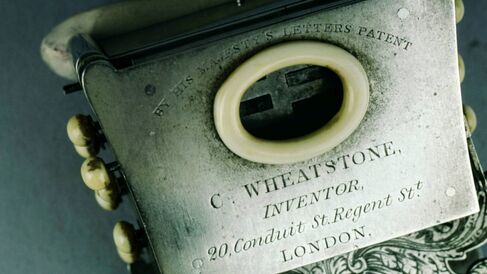Wheatstone's Symphonium

Sir Charles Wheatstone(1802-1875) was an important 19th century physicist and inventor. He had a lifelong fascination with music and acoustics and invented this beautiful instrument, the symphonium (patented in 1829), which was the precursor to his better known invention, the English concertina.
Astronomy and Empire was the first exhibition in the Whipple Museum's refurbished Special Exhibition Gallery
Running until Summer 2019, the exhibition explored the tangled history of science and the British Empire through the instruments, tools, and practices of those sent around the globe to observe, survey, navigate, and chart on behalf of Imperial interests.
The British Empire was built on scientific labour. Precision instruments made in London, charts published by the Royal Observatory, chronometers set to Greenwich time: all of these material tools and many others were essential for the navigation of Britain's ships to far flung corners of the globe. On foreign soil, astronomers, surveyors, and geographers worked side by side with administrators and the military during British efforts to discover, conquer, settle, and manage new colonies. And once established, the imperial world also served as a crucial field site for numerous astronomical enterprises, from the periodic observation of eclipses to the establishment of major new observatories.
'Case Studies' bring the work of the Department of History and Philsophy of Science into the Museum. These are single display case exhibits produced by students and staff that provide an opportunity to present current research or an area of personal interest.
Usually, historians and philosophers communicate their work through papers and talks. The Case Studies provide a different, more visual, medium for sharing ideas, and visitors have the opportunity to learn about the work taking place within the Department. A wide variety of topics are presented, including imagery of the moon dating from the 17th to 19th centuries, a consideration of human understanding, and a study of the problems and successes in using instruments to interpret texts - and vice versa. The Case Studies series has inspired others to utilise the collection further and more case studies are in the advanced planning stages.
Case Studies that are currently on display in the Main Gallery:
- Embryos in Wax by Professor Nick Hopwood
Past Case Studies
Past case studies include the work of the instrument maker Elias Allen, the use of the blowpipe and the mapping of Australia during the 19th century.
- Kitchen Chemistry by Dr Salim Al-Gailani
- Science and Rascism in the Nineteenth Century by Dr James Poskett
- Instruments of Translation by Cambridge Latin Therapy Group
- Looking at the Moon by Janet Vertesi
- Science for the Traveller by Dr Brian Dolan
- Instruments of Attraction by Dr Patricia Fara
- Representations of Newton by Dr Patricia Fara
- Wave Motion in the 19th Century by Dr Chris Haley
- A Century of Use by Anna Märker
- Reworking Scientific Practice by Dr Klaus Staubermann
Operation
The symphonium is similar to the mouth organ insofar as the sound is generated by blowing over thin metal reeds. The symphonium allows the player to sound all twelve notes of the chromatic scale. The main difference is that on the symphonium the player blows through only one hole, finding the individual notes by pressing delicately engineered small buttons on either side.
Biography
Charles Wheatstone was born in Gloucestershire, England, in 1802, the son of a shoe maker called William. The family moved to London in 1806 where William's brother (also called Charles) ran a musical instrument shop. Charles the younger was thus exposed to music and the science of acoustics from an early age, and he maintained a lifelong fascination with both areas. At the age of sixteen he had invented his first musical instrument and he filed his first patent on "Construction of Wind Instruments" in 1829.
Wheatstone went on to become one of the most famous scientists of the 19th century, but not because of his work in acoustics. Instead, he is most well known for his work in electricity as the co-inventor of the telegraph. He also conceived of the telephone and the microphone, although his designs were somewhat different from those that we know today - Wheatstone's devices transmitted sound through the vibrations of rods instead of converting them to electrical signals.
King's College, London
Wheatstone was a brilliant scientist but painfully shy in front of large audiences, which made him a very poor lecturer. Nevertheless, in 1834 King's College London headhunted Wheatstone to be the first Professor of Experimental Philosophy in their new experimental sciences laboratory (one of the very first in the world, predating Cambridge's Cavendish Laboratory by some forty years). Wheatstone continued in this post until his death in 1875, leaving most of his scientific writings and instruments to King's who renamed the laboratory after him in his honor. In 1986 the Whipple purchased a number of 19th century acoustical items from King's college, and these form the backbone of our acoustics collection.
Torben Rees
Torben Rees, 'Wheatstone's symphonium', Explore Whipple Collections, Whipple Museum of the History of Science, University of Cambridge, 2009
